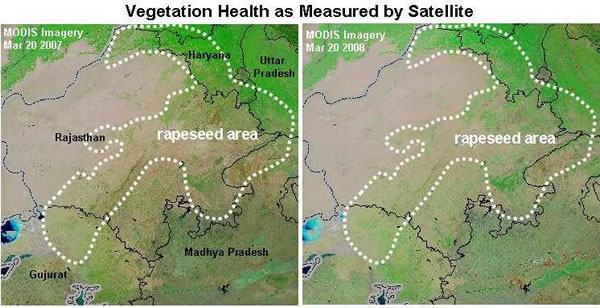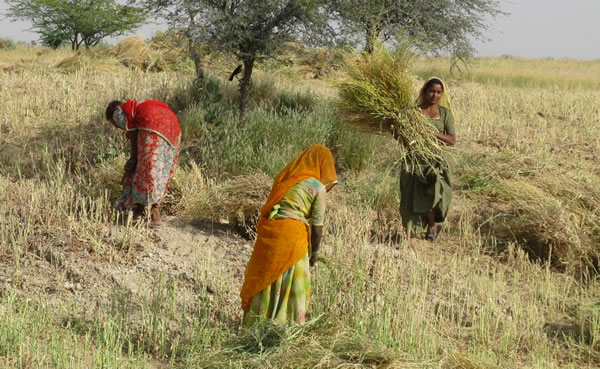India Rapeseed Production Estimate Below Last Season
PRODUCTION SITUATION
The 2007/08 crop, planted in November 2007, with harvest completed by May 2008 is forecast at 5.5 million tons, down 0.3 million or 5 percent from last year. Foreign Agricultural Service agricultural analysts from Washington, DC and New Delhi traveled through areas of central and western regions of India, which are important rabi (winter season) crop production regions. FAS staff assessed crop conditions and met with industry and government officials in the agricultural states of Madhya Pradesh, Maharashra and Rajasthan. Numerous observations of the crop were made in these important agricultural states of India.
The state of Rajasthan produces approximately 38 percent of India’s annual rapeseed crop. FAS interviews and field travel indicate that an average rapeseed output is anticipated this season. The factors contributing to this year’s production level are as follows.
- Area reduction as farmers shifted to wheat.
- Area reductions resulting from early season dryness.
- Average yield as observed from field and satellite observations.
RAPESEED GROWING REGIONS
Rapeseed is grown throughout the country, but three states account for most of the production: Rajasthan (40%), Haryana (16%), and Uttar Pradesh (16%). See the following "India Rapeseed Distribution" map for location of important districts.

AREA DECLINE
Area is down this season, as rapeseed land was shifted into wheat particularly in the states of Haryana and Rajasthan. Area is estimated at 5.9 million hectares, down 0.7 million or 11 percent from last year. According to the latest government of India (GOI) data, the rabi or winter season rapeseed planting is down from last year. GOI data from the beginning of April indicated that the 2007/08 rapeseed crop had been sown on 6.0 million hectares, as compared to 6.6 million for the same time period last season. Assuming average abandonment, the area harvested is estimated at 5.9 MHa. The Indian rapeseed crop is grown during the winter or rabi season and competes with wheat in the major producing states. Dry conditions at sowing and changes in support price policy announced in October 2007 led farmers to plant fewer rapeseed hectares. The Minimum Support Price (MSP) or procurement price established by the Government of India favors wheat over rapeseed this season. The wheat MSP was lifted from 750 Rupees (per 100 kilograms) to a new high of 1000 Rupees for the current season. This results in a 33 percent increase on a year-to-year basis for wheat; in contrast the rapeseed MSP was bolstered only 6 percent year-to-year, from 1715 to 1800 Rupees. The results of these factors on area, can be seen in the following chart which tracks total hectares sown to rapeseed for this seaons versus last.

The current season area reduction can also be corroborated through a comparison of satellite data from March 2008 and March 2007. The MODIS satellite scenes were imaged over the major rapeseed producing region of India. Vegetation in these satellite images are represented by the green and green-brown tones, where as tan tones particularly as seen in western Rajasthan represent soil and desert scrubland. In the 2007 scene (left), the extent of vegetation is marginally greater than that found in the 2008 scene (right). This is further evidence that Rajasthan crop area declined this season.

YIELD FORECAST
India's oilseed yields are among the lowest in the world, as oilseeds are typically grown on marginal land and are rain fed. Moreover, the use of high yielding varieties is negligible. Yield is currently forecast at 932 kilograms per hectare and is similar to the five-year average.
FIELD VISITS
In late March rapeseed harvest was underway with an estimated 40% having been cut. Hand cutting by sickle is common in most of the region. The crop is cut preserving most of the stalk length and then collected into large piles. The cut crop will remain in the field to dry for several days prior to threshing. After the crop dries to an optimum moisture content it will then be threshed either manually or with the use of a portable threshing machine. The following photos taken in the state of Rajasthan, at the end of March, show typical harvest operations of cutting, carrying, and stacking the crop for drying.


Current USDA area and production estimates for grains and other agricultural commodities are available on IPAD's Agricultural Production page or at PSD Online.
|

